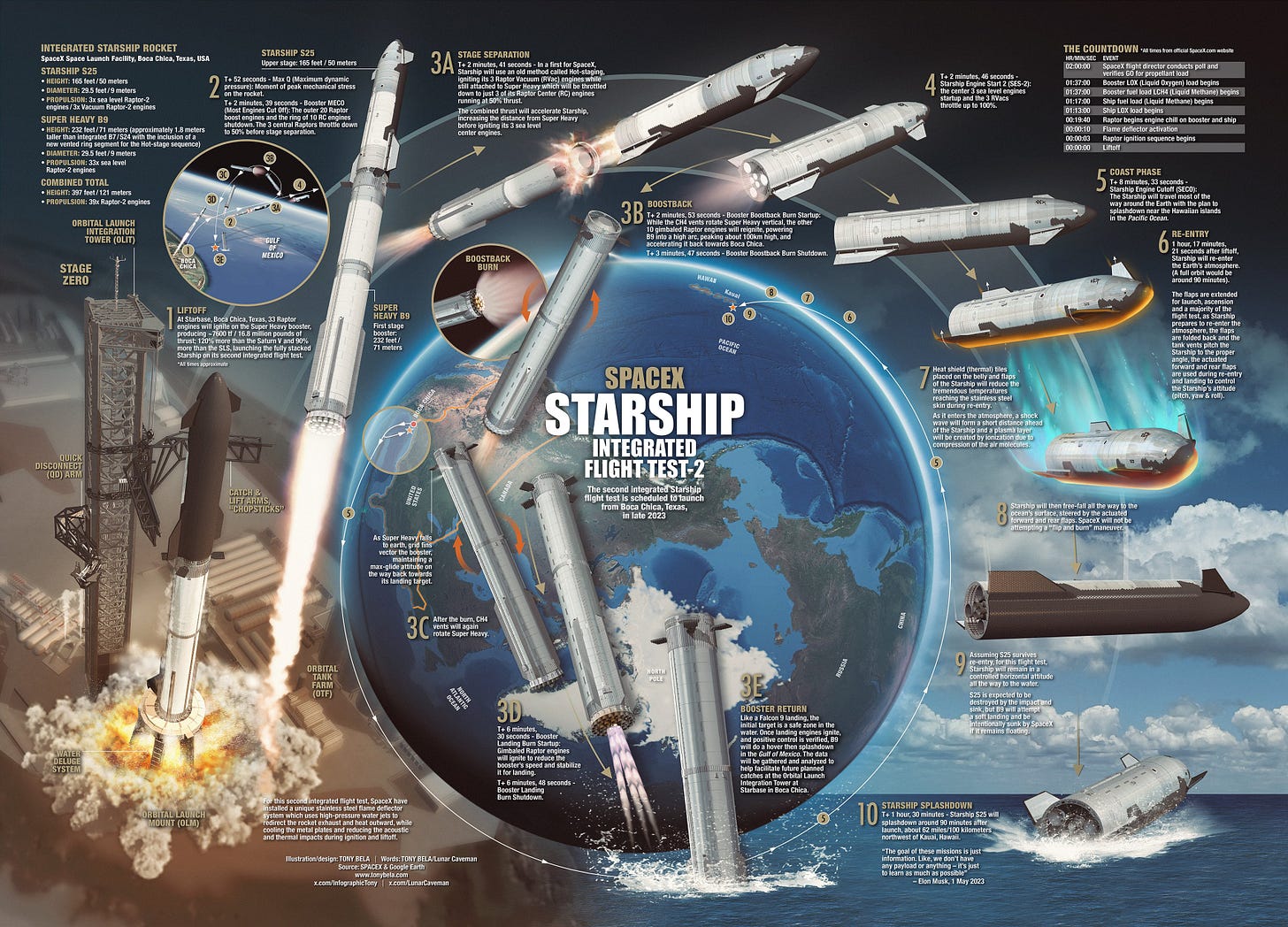SpaceX's Starship Test Flight 2: What will happen and why it matters
The Starship flight test 2 launch is scheduled for TOMORROW!
Watch it live here at 8am Eastern, 5am Pacific. The launch window is only 20 minutes, so if they find any issues, it will likely be scrubbed to a new date.
If you’re excited (or might be) but don’t follow Starship closely, this post is for you.
Starship is SpaceX's fully reusable rocket designed for missions to Earth orbit, the Moon, Mars, and beyond. It’s the biggest rocket ever flown, taller than the Statue of Liberty, with the capacity of an entire space station.
Why is Starship so important?
Starship represents a giant leap towards affordable space travel and expanding Earth’s ecosystem into our galaxy. SpaceX has already reduced costs by 10x with Falcon, and Starship could push it down another 10x. It will be critical for all future NASA programs and expanding our knowledge of the universe.
For more on the details of why Starship makes space travel so cheap, see my essay from 2021 on the future of space.
Starship began with design concepts in 2012. From 2019-2021 SpaceX tested a variety of prototypes, but achieved a milestone with a successful high-altitude flight and landing of SN15 in May 2021. The first orbital test flight in April 2023 ended explosively, yet it marked a significant learning opportunity for SpaceX.
This is a critical part of SpaceX’s culture: rapid prototyping, frequent testing, and a tolerance for failure, allowing for swift iteration and improvement. It's a build-test-learn philosophy that's a world apart from traditional aerospace practices. This has enabled faster innovation and adaptation to real-world challenges.
Who said failure wasn't an option?
In April, Starship's test flight saw the rocket experience engine failures and loss of control, leading to an explosion, or RUD (rapid unscheduled disassembly). While the mission did not achieve all its goals, the test was an essential learning step, not a failure, as it provided critical data for future iterations.
Why has it been 7 months between tests?
SpaceX correcting their issues from test 1, in particular building a new launch pad and water deluge system as the first one was destroyed (due to the surrounding ecosystem, they can’t build a trench to divert flames).
Working with the FAA, and later Fish & Wildlife Services, who were conducting thorough safety and environmental reviews. Slowness of the FAA was partly due to their inability to meet permitting demand — a lot of which is from SpaceX's frequent Falcon launches.
Integrated Flight Test 2 aims to launch Starship from Boca Chica, Texas, achieve stage separation, and reach orbit. The bottom booster is expected to splash down in the Gulf of Mexico, while the upper Starship should travel eastward around the world and land in the Pacific Ocean near Hawaii after re-entry.
Tony Bela has a great infographic on what to expect from the launch:
If you can’t watch the launch, make sure to check out the recap tomorrow.
And remember: Failure is an expected outcome of test flights like this!
Everyone would love to see 100% mission success, but tests are designed to push the system to its limits in real conditions to identify weaknesses. This iterative process is essential for developing a reliable and robust spacecraft capable of fulfilling SpaceX's interplanetary ambitions.
More links if you’re still interested:
At long last, the glorious future we were promised in space is on the way. “If humanity wants to level up as a spacefaring species, this is the clear path forward.
Finally, we are walking it.”
The Future of Space, Part II: Where are we headed in the next 10+ years?





"Failure is an expected outcome of test flights like this!" Thank you!
Run-of-the-mill “journalists” don’t seem to “get” this. Technical innovations as complex as this one involve risk, including a high risk of failure. It is through these failures that progress is made.
Hence Risk & Progress ;)